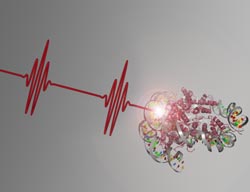Laser pulses reveal DNA repair mechanisms

<br>
Understanding the cellular response to DNA strand breaks is crucial to decipher the mechanisms maintaining the integrity of our genome. In eukaryotic cells, the molecular events triggered by DNA damage are strongly influenced by the local chromatin environment surrounding the lesion. The ensuing DNA repair process, in turn, impacts on chromatin structure.
In order to understand how these two fundamental processes are mutually connected, both chromatin rearrangements induced by DNA damage as well as DNA repair activity have to be visualized in living cells.
Elisa Ferrando-May and a team from University of Konstanz now present a novel method to visualize how the mobility of nuclear proteins changes in response to localized DNA damage. Their new approach enables to inflict DNA damage without interfering with a subsequent mobility measurement by fluorescence photoactivation.
It is based on nonlinear photoperturbation using infrared femtosecond (fs) laser pulses. The assay detects how the dynamics of nuclear proteins is affected by localized DNA strand breaks, irrespective of their recruitment behavior.
The scientists induce DNA strand breaks via nonlinear excitation with fs laser pulses at 1050 nm in a 3D-confined subnuclear volume. After a time delay of choice, they analyze protein mobility within this volume by two-photon photoactivation of PA-GFP fusion proteins at 775 nm. The time delay can be chosen freely permitting to probe protein mobilities at different subsequent stages of the DNA damage response.
By changing the position of the photoactivation spot with respect to the zone of lesion the influence of chromatin structure and of the distance from damage can be investigated. Due to the local confinement of multiphoton absorption it is possible to examine spatially distinct subnuclear areas, such as eu- and heterochromatin.
As first applications, the scientists demonstrated a locally confined, time-dependent mobility increase of histone H1.2, and a progressive retardation of the DNA repair factor XRCC1 at damaged sites. (Text contributed by K. Maedefessel-Herrmann)
M. Tomas, P. Blumhardt, A. Deutzmann, T. Schwarz, D. Kromm, A. Leitenstorfer, E. Ferrando-May, Imaging of the DNA damage-induced dynamics of nuclear proteins via nonlinear photoperturbation, J. Biophotonics 6(8), 645-655 (2013); doi: http://dx.doi.org/10.1002/jbio.201200170
Regina Hagen
Journal Publishing Manager, Journal of Biophotonics
Managing Editor, Physical Sciences
Global Research
Wiley-VCH Verlag GmbH & Co. KGaA
Rotherstrasse 21
10245 Berlin
Germany
T +49 (0)30 47 031 321
F +49 (0)30 47 031 399
jbp@wiley.com
Media Contact
All latest news from the category: Life Sciences and Chemistry
Articles and reports from the Life Sciences and chemistry area deal with applied and basic research into modern biology, chemistry and human medicine.
Valuable information can be found on a range of life sciences fields including bacteriology, biochemistry, bionics, bioinformatics, biophysics, biotechnology, genetics, geobotany, human biology, marine biology, microbiology, molecular biology, cellular biology, zoology, bioinorganic chemistry, microchemistry and environmental chemistry.
Newest articles

Properties of new materials for microchips
… can now be measured well. Reseachers of Delft University of Technology demonstrated measuring performance properties of ultrathin silicon membranes. Making ever smaller and more powerful chips requires new ultrathin…

Floating solar’s potential
… to support sustainable development by addressing climate, water, and energy goals holistically. A new study published this week in Nature Energy raises the potential for floating solar photovoltaics (FPV)…

Skyrmions move at record speeds
… a step towards the computing of the future. An international research team led by scientists from the CNRS1 has discovered that the magnetic nanobubbles2 known as skyrmions can be…





















